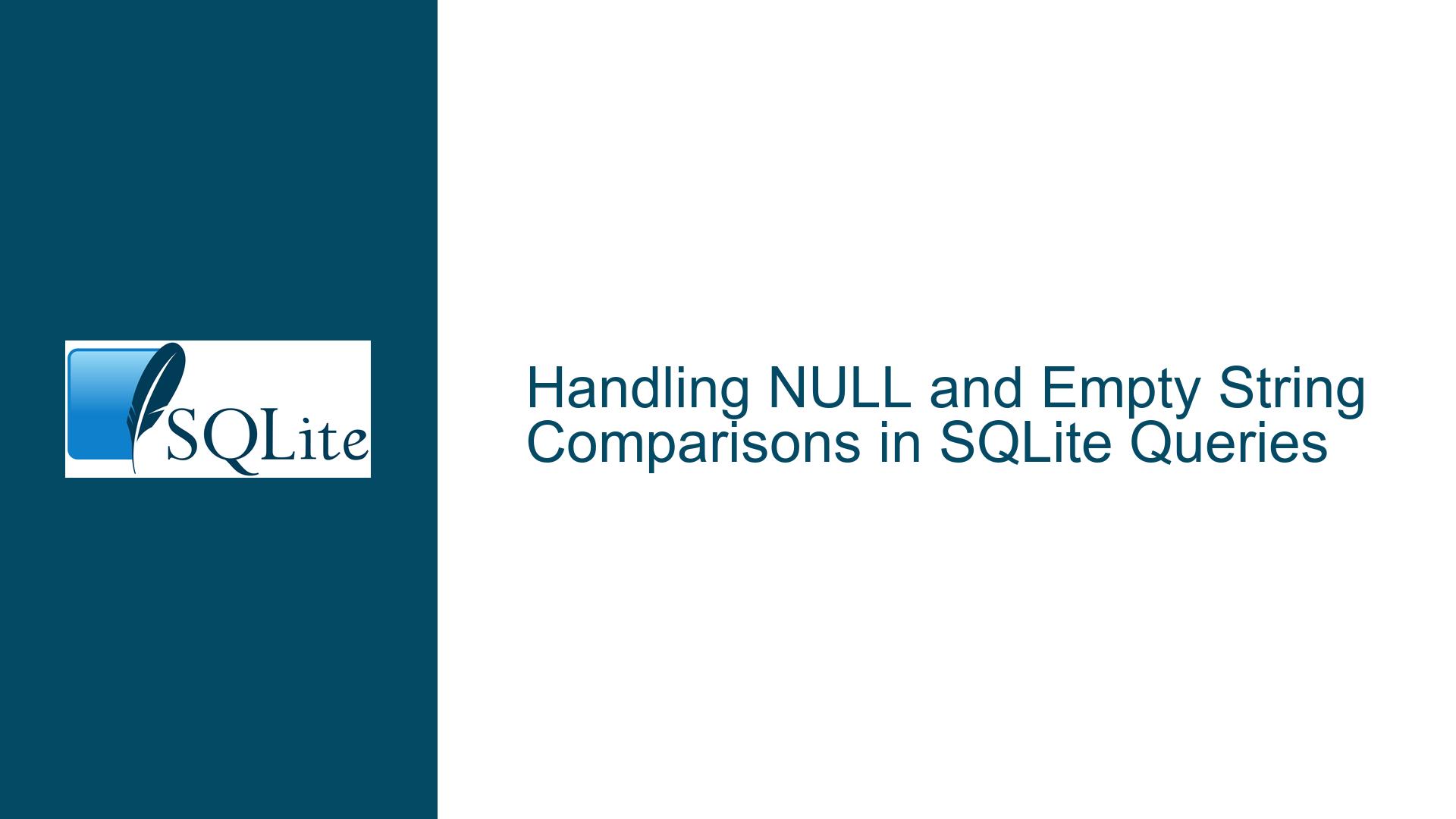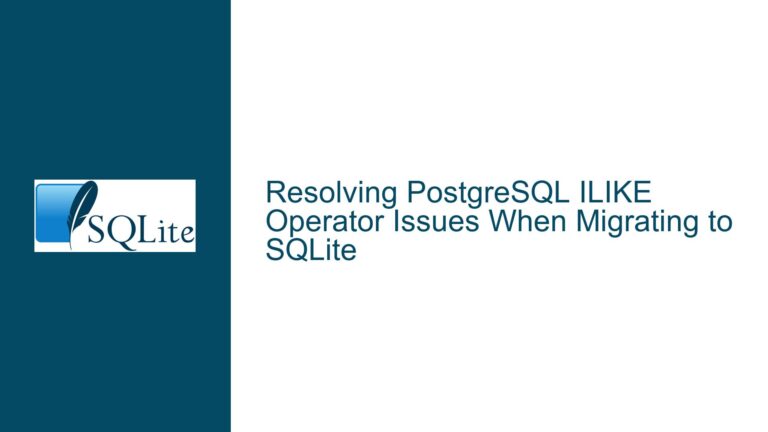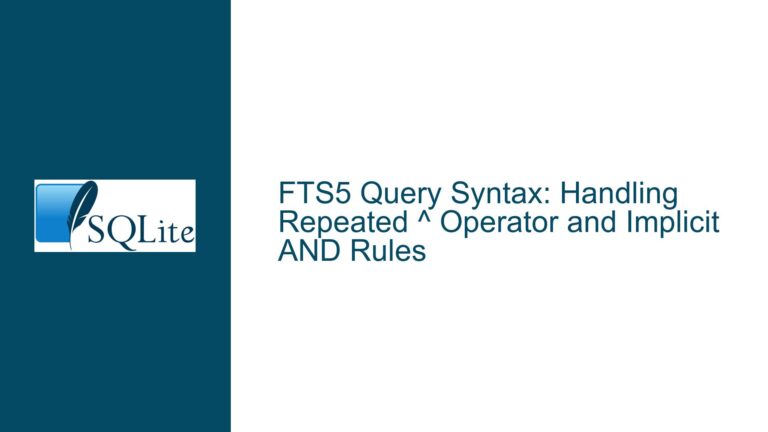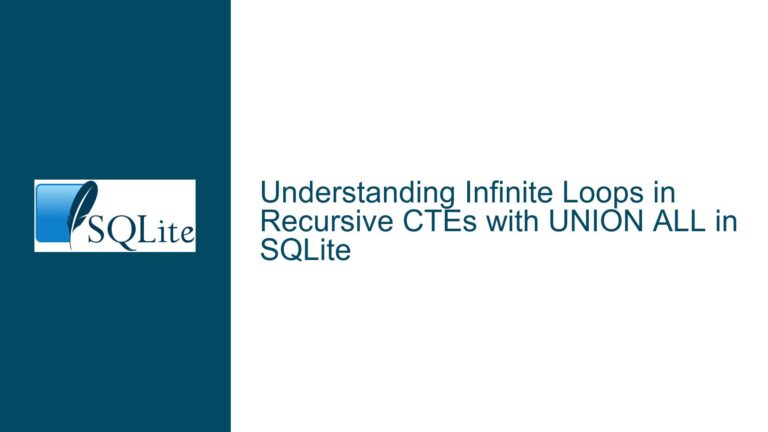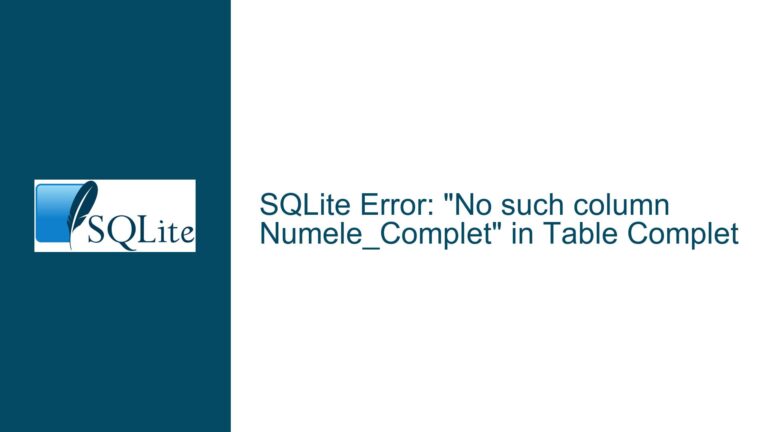Handling NULL and Empty String Comparisons in SQLite Queries
NULL vs. Empty String: The Hidden Culprit in Query Results
When working with SQLite, one of the most common yet subtle issues developers encounter is the distinction between NULL and an empty string (''). These two entities, while seemingly similar, behave differently in SQL operations, particularly in comparisons. This discrepancy can lead to unexpected query results, especially when filtering or joining data. The core issue arises when a column contains a mix of NULL values and empty strings, and the query logic does not account for both possibilities.
In SQLite, NULL represents the absence of a value, while an empty string is a valid string value with zero length. When performing comparisons using operators like =, <>, or !=, SQLite treats NULL as an unknown value. This means that any comparison involving NULL will yield NULL (which is considered false in a WHERE clause), rather than TRUE or FALSE. For example, the expression NULL = NULL evaluates to NULL, not TRUE. Similarly, NULL <> 'value' also evaluates to NULL. This behavior can cause queries to exclude rows that should logically be included, leading to incomplete or incorrect results.
The problem is exacerbated when data is sourced from external systems that inconsistently represent "empty" values. Some systems may use NULL to indicate the absence of data, while others may use an empty string. When such data is imported into SQLite without normalization, queries that do not explicitly handle both cases will fail to produce the expected results.
Inconsistent Data Representation and Comparison Logic
The root cause of the issue lies in the inconsistent representation of "empty" values in the dataset and the comparison logic used in the query. In the provided scenario, the Methodology column in the Project_List table contains a mix of NULL values and empty strings. The query aims to identify rows where the Methodology value has changed compared to the previous entry for the same ProjID. However, the initial query fails to account for the possibility that the previous Methodology value could be either NULL or an empty string.
The comparison oldv <> newv in the WHERE clause is problematic because it does not handle NULL values correctly. In SQLite, the <> operator returns NULL when either operand is NULL, which effectively excludes those rows from the result set. This behavior is consistent with the SQL standard but can be counterintuitive for developers who expect NULL values to be treated as equal to other NULL values or empty strings.
To complicate matters further, the subquery used to retrieve the previous Methodology value (oldv) does not normalize the data. If the previous value is NULL and the current value is an empty string (or vice versa), the comparison oldv <> newv will yield NULL, causing the row to be excluded from the results. This inconsistency in data representation and comparison logic is the primary reason why the initial query fails to return the expected results.
Using COALESCE and IS NOT for Robust Comparisons
The solution to this issue involves normalizing the data within the query to ensure consistent comparisons. The COALESCE function is a powerful tool for handling NULL values in SQLite. It returns the first non-NULL value in its argument list, making it ideal for converting NULL values to a consistent representation, such as an empty string or a placeholder value. By wrapping the Methodology column in a COALESCE function, the query can ensure that both NULL values and empty strings are treated uniformly.
For example, the expression COALESCE(Methodology, 'null') converts NULL values to the string 'null', while leaving empty strings unchanged. This normalization allows the comparison oldv <> newv to work as intended, as both oldv and newv are guaranteed to be non-NULL. However, it is important to choose a placeholder value that does not conflict with valid data in the column.
In addition to using COALESCE, the comparison operator should be replaced with IS NOT when dealing with NULL values. The IS NOT operator is specifically designed to handle NULL comparisons correctly. For example, the expression oldv IS NOT newv will return TRUE if oldv and newv are different, even if one or both of them are NULL. This ensures that rows with changing Methodology values are included in the results, regardless of whether the change involves NULL values or empty strings.
The revised query should also ensure that the ORDER BY and ProjID constraints are applied consistently. In the original query, the ORDER BY clause is placed outside the subquery, which can lead to unexpected results if the subquery returns multiple rows for the same ProjID. Moving the ORDER BY clause inside the subquery ensures that the correct previous Methodology value is selected for each row.
Here is the corrected query:
SELECT ProjID,
Updated_By,
InsertDate,
var,
oldv,
newv
FROM (
SELECT ProjID,
Updated_By,
InsertDate,
'Methodology' AS var,
(
SELECT COALESCE(Methodology, 'null')
FROM Project_List
WHERE ProjID = o.ProjID
AND InsertDate < o.InsertDate
ORDER BY InsertDate DESC
LIMIT 1
) AS oldv,
COALESCE(Methodology, 'null') AS newv
FROM Project_List AS o
WHERE ProjID = 'PR0000014752'
ORDER BY InsertDate ASC
)
WHERE oldv IS NOT newv;
This query normalizes the Methodology values using COALESCE, ensures consistent ordering with the ORDER BY clause, and uses the IS NOT operator for robust comparisons. By addressing the issues of inconsistent data representation and comparison logic, the query now produces the expected results, even when the Methodology column contains a mix of NULL values and empty strings.
Best Practices for Handling NULL and Empty Strings in SQLite
To avoid similar issues in the future, it is essential to adopt best practices for handling NULL values and empty strings in SQLite. These practices include:
Data Normalization: Ensure that all "empty" values in the dataset are represented consistently, either as
NULLor as an empty string. This can be achieved by cleaning and normalizing the data before importing it into SQLite or by applying data transformation rules within the database.Use COALESCE for Default Values: When querying columns that may contain
NULLvalues, use theCOALESCEfunction to provide a default value. This ensures that all values are treated consistently in comparisons and calculations.Use IS NULL and IS NOT NULL for NULL Comparisons: When checking for
NULLvalues, always use theIS NULLorIS NOT NULLoperators. These operators are specifically designed to handleNULLcomparisons correctly and avoid the pitfalls of using=or<>.Document Data Assumptions: Clearly document any assumptions about the data, such as the expected representation of "empty" values. This documentation helps other developers understand the data model and write queries that handle edge cases correctly.
Test for Edge Cases: When writing queries, test them with a variety of data scenarios, including
NULLvalues, empty strings, and valid data. This testing helps identify potential issues before the queries are deployed in production.
By following these best practices, developers can avoid common pitfalls related to NULL values and empty strings in SQLite and ensure that their queries produce accurate and consistent results.
Conclusion
Handling NULL values and empty strings in SQLite requires a clear understanding of how these entities behave in comparisons and a disciplined approach to data normalization and query design. By using tools like COALESCE and IS NOT, developers can write robust queries that handle edge cases gracefully and produce the expected results. Adopting best practices for data management and query design further reduces the risk of encountering similar issues in the future, ensuring that SQLite databases remain reliable and efficient.
